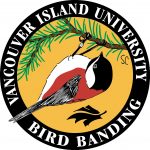The Canada Goose – Branta Canadensis
The Canada goose (Branta canadensis) is a prominent, widespread species found across North America. It is a very conspicuous bird, its large size and loud honking call make it hard to miss. It is a bird that is very familiar to many people, particularly because large numbers of geese have become well-adapted to urban areas such as lawns, golf courses, sports fields, airports, and urban bodies of water (Smith et al. 1999; Cornell University 2015). As shown in Figure 1, it occurs throughout most of North America and into southwestern Greenland; also, introduced populations exist in many parts of Western Europe (Butchart et al. 2010).

Range of the Canada goose in North America [Source]
Canada geese can be found in a wide variety of habitats, such as lakes, rivers, tundra, bogs, swamps, marshland, estuaries, agricultural land, and near shore marine areas (Johnson 2011; Cornell University 2015). They feed on a wide variety of foods, including grasses, shoots, leaves and aquatic plants; they also take advantage of waste crops such as grain, beans, or corn (Ducks Unlimited 2015; University of Auckland 2010). In recent decades, Canada geese have become well adapted to urban areas (Regional Canada Goose Management Strategy (RCGMS) 2012) . This adaptation greatly reduces exposure to predation, and also reduces mortality due to hunting because hunting generally does not occur within urban areas; this combination has resulted in enormous population growth over the past four decades (University of Auckland 2010; State of Connecticut 2012).
![Population growth of Canada geese in Greater Victoria [Source]](http://studentblogs.viu.ca/biol325canadagoose/files/2015/10/Screen-Shot-2015-10-22-at-10.56.25-PM.png)
Population growth of Canada geese in Greater Victoria (1958-2010) [Source]
There are currently seven recognized subspecies of the Canada goose throughout North America (RCGMS 2012; Cornell University 2015). Formerly there were 11 subspecies, but in 2004 it was agreed that the very similarly coloured but much smaller-bodied “cackling Canada goose” subspecies were indeed separate species. These smaller-bodied species were designated the “cackling goose” (Branta hutchinsii), of which there are four subspecies (Birdweb 2015; Cornell University 2015) On the Pacific Coast, there are 5 subspecies of the Canada goose (Branta canadensis): the lesser Canada goose (B. c. parvipes), the Vancouver Canada goose (B. c. fulva), the western Canada goose (B. c. moffitti), and the dusky Canada goose (B. c. occidentalis) (Pearce and Bollinger 2003). Distinguishing between the subspecies in the field isn’t easy, although the lesser Canada goose is the smallest amongst the Pacific subspecies (Sibley 2007), and the dusky Canada goose has the darkest coloured body (Pearce and Bollinger 2003). Culmen length and total tarsus length can be used to definitively determine subspecies, because using body colour is not reliable (Pearce and Bollinger 2003).
The Pacific subspecies of Canada geese can be found along the Pacific coast from Alaska to California, although some do not range as far north or south as others (Bromley and Rothe 2003). Populations of Canada geese on the Pacific Coast are stable to increasing, the exception to this trend is the dusky Canada goose, which has experienced a 40 – 50% decrease in its breeding population since the 1970s (Bromley and Rothe 2003). Overall, the North American population has experienced an average increase of 10.78% per year over the past 40 years (USGS 2012).
As waterfowl, Canada geese require open water as part of their habitat. This factor, along with availability of food, dictates when migratory populations of Canada geese migrate north in the spring or south in the fall (Ducks Unlimited 2015). Many populations will winter just as far south as need be to obtain open water, while others migrate as far south as subtropical areas (Geese Peace unkown; University of Wisconsin 2007; Cornell University 2015). Although some populations may migrate the entire length of North America, most resident populations do not migrate at all; this is because geese nest in the area where they are born, so introduced populations do not have the urge to migrate (Brakhage 1965; Geese Peace unkown). In the fall, migration can cover up to 1000 kilometers in a single day; however, spring migration typically occurs in a series of stopovers so that the geese can build up fat reserves for breeding (Ducks Unlimited 2015).

Much of what is known about Canada geese is due to banding, which allows biologists to track their distribution and movement
Canada geese typically reach breeding maturity at 3 years of age, although 2 years is not uncommon, and mate for life (Smith et al. 1999). Canada goose females return to the same area where they were hatched. They construct a nest on the ground and line it with their own down; nests are usually located within 150 feet of a water body, and islands are often favoured (Smith et al. 1999). Nesting occurs between late March to early May, depending on latitude and weather conditions (Smith et al. 1999). On average, 5 eggs are laid and incubated for 28 days. During this time, the male goose closely guards the nest. Once hatched, the goslings spend approximately 24 hours in the nest before abandoning it (Brakhage 1965). The goslings are then closely guarded by their parents and are raised in and around the chosen body of water. Goslings usually fledge within 4-7 weeks, depending on size of the subspecies, with the smaller subspecies fledging earlier (National Audubon Society 2015). During this time, the parents also moult their primary flight feathers and are flightless, but complete their moult at the same time as the juvenile geese are ready to fly (Link 2015). On average, Canada geese live to be 12 years of age, with a range of 10 – 25 years (Johnson 2011); however, the oldest wild goose on record was 30 years 4 months old (USFWS 2015).
References:
Smith, A.E., Craven, S.R., and Curtis, P. D. 1999. Managing Canada geese in urban environments. Jack Berryman Institute Publication 16, and Cornell University Cooperative Extension, Ithaca, N.Y.; [cited 2015 Sep 25]. Available from: https://ecommons.cornell.edu/bitstream/handle/1813/66/Managing%20Canada%20Geese;jsessionid=15B926B1D86681CE745746849992342A?sequence=2
Cornell University [Internet]. 2015. Canada goose – branta canadensis: life history; Ithaca, NY: Cornell Lab of Ornithology; [cited 2015 Sep 25]. Available from: http://www.allaboutbirds.org/guide/Canada_Goose/lifehistory
Butchart, S., Ekstrom, J., Khwaja, N., and Pilgrim, J. [Internet]. 2015. Birdlife international species factsheet: canada goose – branta canadensis; [cited 2015 Sep 25]. Available from: http://www.birdlife.org/datazone/speciesfactsheet.php?id=384
USFWS [Internet]. 2015. Swans and geese; [cited 2015 Sep 26]. Available from: http://flyways.us/duck-identification-resources/swans-and-geese
Johnson, S. [Internet]. 2011. Beauty of birds: canada geese; [cited 2015 Sep 26]. Available from: http://beautyofbirds.com/canadageese.html
Ducks Unlimitied [Internet]. 2015. Learn about wetlands: canada goose – branta canadensis; Stonewall, MB: Ducks Unlimited Canada; [cited 2015 Sep 28]. Available from: http://www.ducks.ca/learn-about-wetlands/wildlife/canada-goose/
University of Auckland [Internet]. 2010. Branta canadensis (bird); Auckland, NZ: Auckland University; [cited 2015 Sep 29]. Available from: http://www.issg.org/database/species/ecology.asp?si=1427&lang=EN
State of Connecticut [Internet]. 2012. Wildlife in connecticut: wildlife fact sheet: canada goose – branta canadensis; Hartford, CT: State of Connecticut; [cited 2015 Oct 1]. Available from: http://www.ct.gov/deep/lib/deep/wildlife/pdf_files/outreach/fact_sheets/cdgoose.pdf
Isaac-Renton, M., Bennett, J.R., Best, R.J., Arcese, P. 2010. Effects of introduced canada geese (branta canadensis) on native plant communities of the southern gulf islands, british columbia; Ecoscience [Internet]; [cited 2015 Oct 1]; 17(4): 394-399. Available from: http://www.bioone.org/doi/full/10.2980/17-4-3332 doi: http://dx.doi.org/10.2980/17-4-3332
Brakhage, G.K. 1965. Biology and behavior of tub-nesting canada geese; J Wildlife Manage [Internet]; [cited 2015 Oct 1]; 29(4): 751-771. Available from: http://www.jstor.org/stable/3798552?pq-origsite=summon&seq=1-%20page_scan_tab_contents#page_scan_tab_contents doi: 10.2307/3798552
Mowbray, T.B., Ely, C.R., Sedinger, J.S., Trost, R.E. [Internet]. 2002. The birds of north america online: canada goose – branta canadensis; Ithaca, NY: Cornell Lab of Ornithology; [cited 2015 Oct 3]. Available from: http://bna.birds.cornell.edu/bna/species/682/articles/introduction
Birdweb [Internet]. 2015. Canada goose – branta canadensis; Seattle, WA: Seattle Audubon Society; [cited 2015 Oct 3]. Available from: http://www.seattleaudubon.org/birdweb/bird/canada_goose
Cornell University [Internet]. 2015. Cackling goose – branta hutchinsii: life history; Ithaca, NY: Cornell Lab of Ornithology; [cited 2015 Oct 5]. Available from: http://www.allaboutbirds.org/guide/Cackling_Goose/lifehistory
Pearce, J.M., Bollinger, K.S. 2003. Morphological traits of pacific flyway canada geese as an aid to subspecies identification and management; J Field Ornithol [Internet]; [cited 2015 Oct 2]; 74(4): 357-359. Available from: http://www.jstor.org/stable/4131045?pq-origsite=summon&seq=1-%20page_scan_tab_contents#page_scan_tab_contents
Sibley, D. [Internet]. 2007. Distinguishing cackling and canada goose; unknown: Sibley Guides; [cited 2015 Oct 4]. Available from: http://www.sibleyguides.com/2007/07/identification-of-cackling-and-canada-goose/
Bromley, R.G., Rothe, T.C., 2003. Conservation assessment for the dusky canada goose (branta canadensis occidentalis baird); Portland, OR: US Department of Agriculture, Forest Service: Pacific Northwest Research Station [Internet]; [cited 2015 Oct 4]. Available from: http://www.arlis.org/docs/vol1/54830739.pdf
USGS [Internet]. 2012. North america breeding survey trend results: canada goose – branta canadensis; [cited 2015 Oct 4]. Available from: http://www.mbr-pwrc.usgs.gov/cgi-bin/atlasa12.pl?01720&1&12&csrfmiddlewaretoken=3YKakk7LxT2ki6NSpl4mstudYCqdW02C
GeesePeace [Internet]. Date unknown. Why geese do not migrate; [cited 2015 Oct 6]. Available from: http://www.geesepeace.com/whygeesedonotmigrate.html
University of Wisconsin [Internet]. 2007. Migratory birds of the great lakes: canada goose migration – page 2; Madison, WI: University of Wisconsin; [cited 2015 Oct 4]. Available from: http://www.seagrant.wisc.edu/birds/Canada_Goose_migration2.html
National Audubon Society [Internet]. 2015. Guide to north american birds: canada goose – branta canadensis; [cited 2015 Oct 4]. Available from: http://www.audubon.org/field-guide/bird/canada-goose
Link, R. [Internet]. 2015. Living with wildlife: canada geese; Olympia, WA: Washington Department of Fish and Wildlife; [cited 2015 Oct 4]. Available from: http://wdfw.wa.gov/living/canada_geese.html
Dawe, N.K., Stewart, A.C. 2010. The Canada goose (branta canadensis) on vancouver island, british columbia; Vancouver, BC: British Columbia Birds, J BC Field Ornithol [Internet]; [cited 2015 Oct 20]; 20: 24-40. Available from: http://www.academia.edu/12104403/The_Canada_Goose_Branta_canadensis_on_Vancouver_Island_British_Columbia._British_Columbia_Birds_20_24-40
Dawe, N.K., Boyd, W.S., Buechert, R., Stewart, A.C. 2011. Recent, significant changes to the native marsh vegetation of the little qualicum river estuary, british Columbia; a case of too many canada geese (branta canadensis)?; Vancouver, BC: British Columbia Birds, J BC Field Ornithol [Internet]; [cited 2015 Oct 20]; 21: 11-31. Available from: http://www.researchgate.net/publication/275032471_Recent_significant_changes_to_the_native_marsh_vegetation_of_the_Little_Qualicum_River_estuary_British_Columbia_a_case_of_too_many_Canada_Geese_%28Branta_canadensis%29
Hume, M. 2010 Dec 21. Bird lover advocates eradication of canada geese. Globe and Mail: Env. Sect. [Internet]; [cited 2015 Oct 20]. Available from: http://www.theglobeandmail.com/news/british-columbia/bird-lover-advocates-eradication-of-canada-geese/article560256/
Braband, L.A., Clark, K.D. 1991. Perspectives on wildlife nuisance control: results of a wildlife damage control firm’s customer survey; Lincolm, NE: University of Nebraska [Internet]; [cited 2015 Oct 21]. Available from: http://digitalcommons.unl.edu/cgi/viewcontent.cgi?article=1007&context=ewdcc5
Lefebvre, J. [date unknown]. Wildlife management responses within the city of calgary; Calgary, AB: University of Calgary [Internet]; [cited 2015 Oct 21]. Available from: http://www.ucalgary.ca/ev/designresearch/projects/EVDS663/wildlifemanagement.pdf
Lefebvre, J. [date unknown]. Wildlife management responses within the city of calgary; Calgary, AB: University of Calgary [Internet]; [cited 2015 Oct 21]. Available from: http://www.ucalgary.ca/ev/designresearch/projects/EVDS663/wildlifemanagement.pdf










